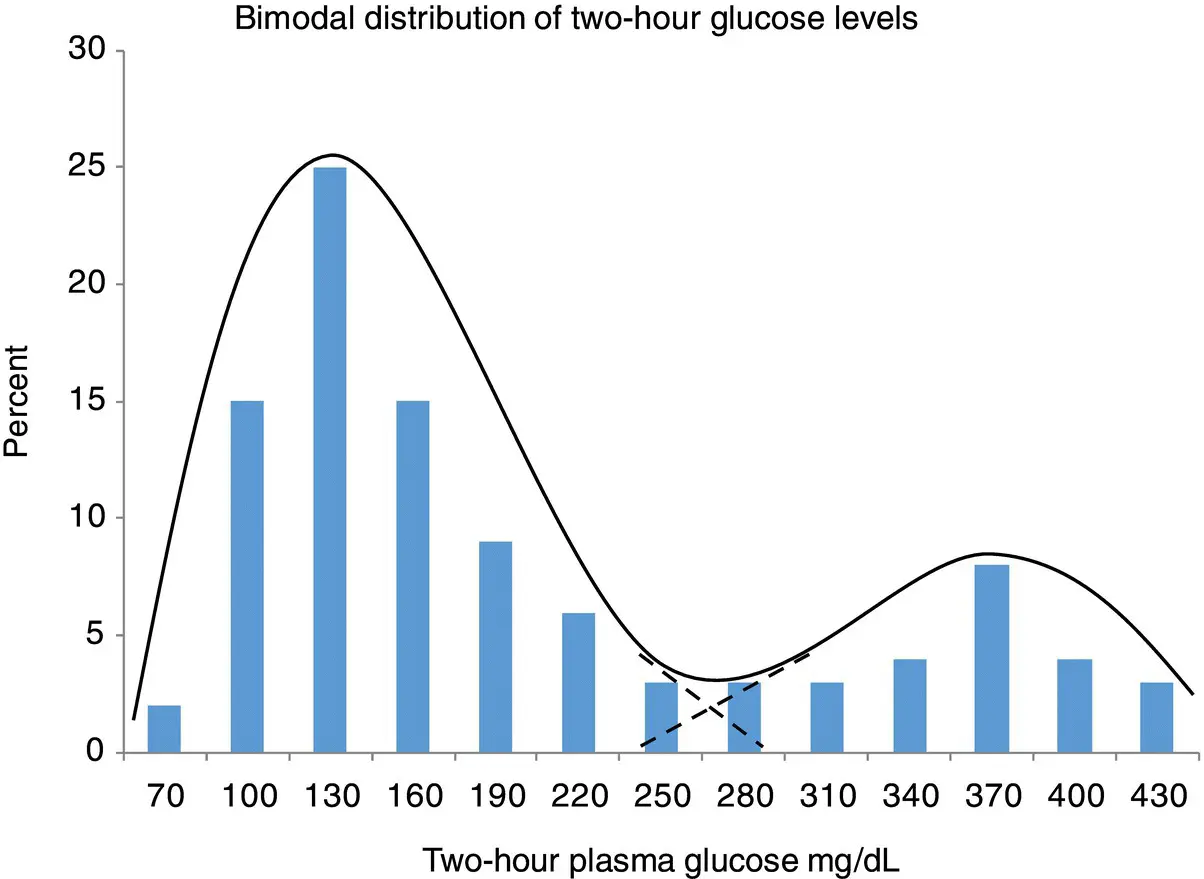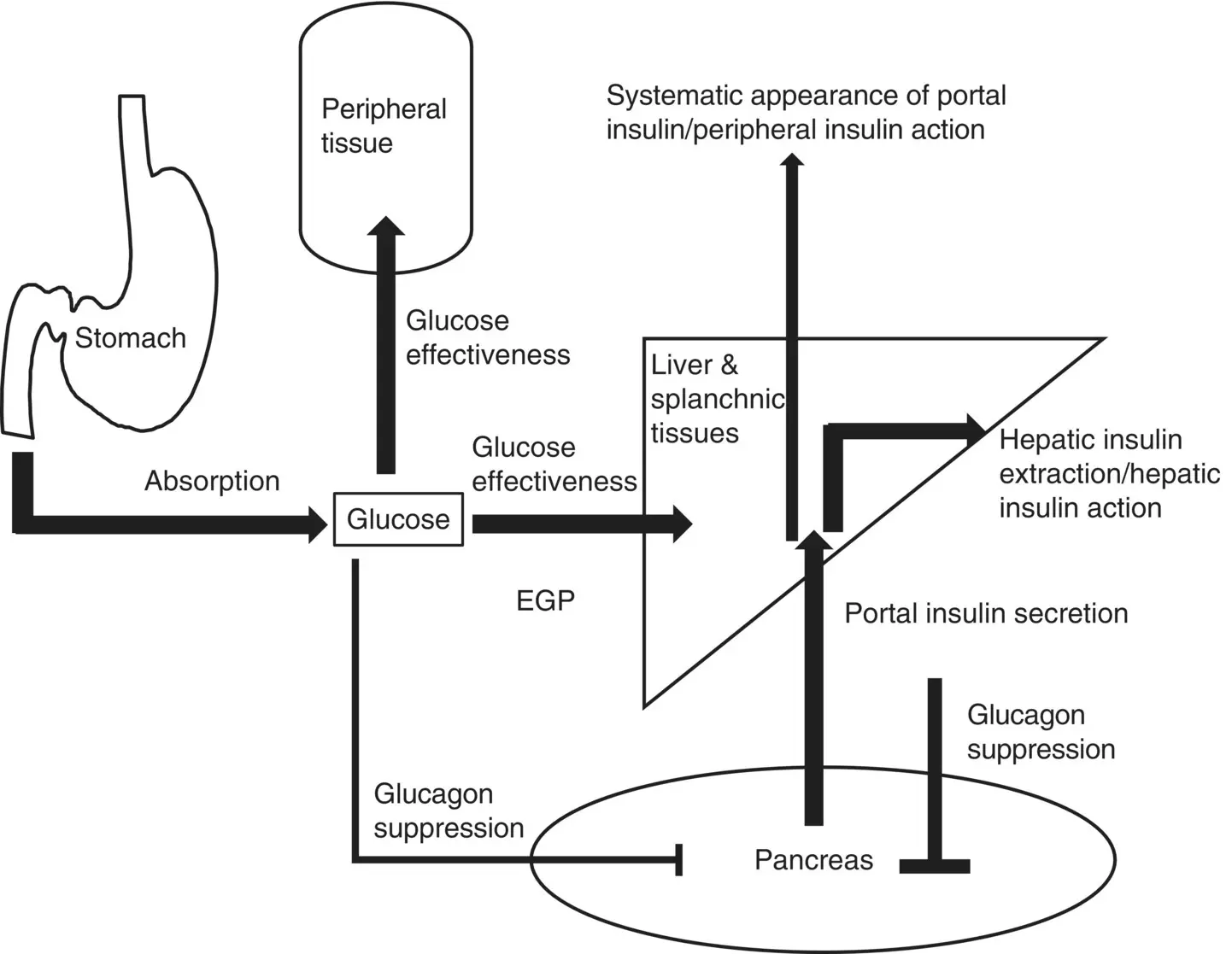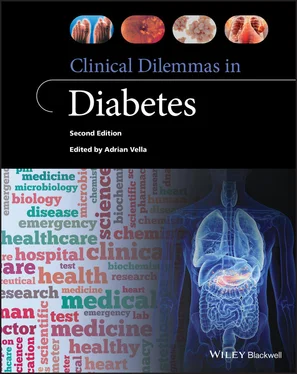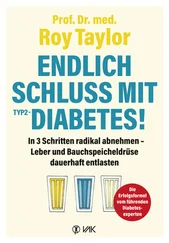
FIG 1.1 Histogram with superimposed composite and component curves to describe the distribution of two‐hour plasma glucose levels following an oral glucose load. Glucose concentrations and frequencies were arbitrarily chosen to illustrate a bimodal distribution. The bimodal glucose distribution can be used to separate individuals into two groups, those with normoglycemia and those with hyperglycemia. Intermediate glucose concentrations between normoglycemia and hyperglycemia helped define the diagnostic thresholds for prediabetes.
Epidemiology of prediabetes
The 2020 National Diabetes Statistics Report published by the Centers for Disease Control and Prevention estimated the prevalence of prediabetes (defined by 2020 ADA criteria) to be 38.0% (95% confidence interval (CI) 35.2–40.8) among adults in the United States (U.S.) [1, 16]. Overall, the prevalence of prediabetes has not changed significantly from 2005–2016. However, the number of U.S. adults who are aware that they have prediabetes increased from 6.5% (95% CI 5.3–7.9) in 2005–2008 to 13.3% (95% CI 11.0–16.0) in 2013–2016. Further, the prevalence of prediabetes increases with age: 29.1% (95% CI 25.2–33.3) of adults 18–44 years of age; 46.3% (95% CI 43.5–49.1) of adults 45–64 years of age; and 51.0% (95% CI 46.5–55.5) of adults ≥ 65 years of age. Prediabetes is also more common in men, whose prevalence is 42.3% (95% CI 38.1–46.5), compared to women, whose prevalence is 33.7% (95% CI 30.7–36.8). The prevalence of prediabetes is similar among racial/ethnic groups and among individuals of different education levels [16].
Pathogenesis of impaired fasting glucose and impaired glucose tolerance
In epidemiologic studies, isolated IGT consistently has a higher prevalence than isolated IFG [17]. The prevalence of IFG and IGT increases with age [17]. In adults less than 55 years of age, IGT is more common in women and IFG is more common in men [17]. This suggests that these two states have different pathophysiologic mechanisms.
Genetics and lifestyle influence the pathogenesis of DM [18, 19]. Although more than 400 genetic signals have been identified as influencing risk for DM2, single polymorphisms add only small degrees of risk [20]. Polymorphisms in the Transcription factor 7‐like 2 ( TCF7L2 ) locus have the largest‐known effect on risk for DM [20, 21]. Compared with non‐carriers, heterozygous and homozygous carriers of the at‐risk TCF7L2 variants have relative risks of developing DM of 1.45 and 2.41, respectively [20, 21].
The relationship between genetics and lifestyle on the pathogenesis of DM was emphasized by a study comparing the prevalence of DM2 in the Pima population in Mexico versus the Pima population in the U.S. [22]. The prevalence of DM2 in the Pima population in Mexico was 6.9%, compared to 38% in the Pima population in the U.S. The prevalence of obesity in the Pima population in Mexico was significantly lower than that in the Pima population in the U.S. By comparison, the latter group also had significantly lower physical activity levels.
Overall, islet cell function is the primary regulator of glucose metabolism, but multiple additional factors contribute. Postprandial and fasting glucose concentrations are determined by insulin secretion, hepatic extraction, insulin action, glucagon suppression, glucose effectiveness, and the rate of gastric emptying ( Figure 1.2) [23–29].
Studies using the minimal model to quantitate insulin secretion and insulin action demonstrated that both indices are lower in subjects with NFG/IGT and IFG/IGT than in subjects with NFG/NGT [25, 26]. However, there was no significant difference in insulin secretion and insulin action between subjects with IFG/NGT and those with NFG/NGT. This implies that insulin secretion declines in concert with insulin action across the spectrum of prediabetes; however, subjects with isolated IFG may have an altered glucose threshold for insulin secretion without other intrinsic defects in β‐cell function.
Using human pancreatic tissue obtained at autopsy, obese individuals with IFG have a 40% deficit in relative beta‐cell volume compared to obese individuals with NFG [30]. Additionally, the diabetes‐associated genetic variation in TCF7L2 is associated with impaired insulin secretion [31–33]. The inability of insulin secretion to compensate for a decline in insulin action results in hyperglycemia.
It is also essential to consider the role of hepatic extraction in the pathophysiology of prediabetes and DM [26]. The peripheral insulin concentration reflects portal insulin secretion, hepatic extraction, distribution, and degradation [34]. Hepatic extraction of secreted insulin has a direct relationship with disposition index. Reduced hepatic extraction in prediabetes and DM may be a compensatory measure to increase circulating insulin. Interestingly, insulin pulse characteristics influence hepatic extraction of insulin, and the diabetes‐associated genetic variation in TCF7L2 is associated with abnormal insulin pulse characteristics [33].
Furthermore, lack of glucagon suppression contributes to hyperglycemia in subjects with impaired insulin secretion [24]. The diabetes‐associated genetic variation in TCF7L2 is associated with impaired glucagon suppression [31, 35]. In a longitudinal study, defects in α‐cell function with elevated fasting glucagon concentrations were associated with a subsequent decline in β‐cell function [36].
Screening recommendations for prediabetes
The 2020 ADA Guidelines recommend screening asymptomatic overweight or obese adults for DM or prediabetes if at least one of the following risk factors is present: first‐degree relative with DM; high‐risk race/ethnicity (e.g. African American, Latino, Native American, Asian American, Pacific Islander); history of cardiovascular disease; hypertension; high‐density lipoprotein cholesterol < 35 mg/dL; triglyceride level > 250 mg/dL; presence of polycystic ovary syndrome; physical inactivity; or other clinical considerations associated with reduced insulin action such as acanthosis nigricans [1]. The 2020 ADA Guidelines further recommend that patients with prediabetes be tested yearly and that women with a history of gestational diabetes be tested lifelong at least every three years. For all other patients, screening should begin at age 45, and if results are normal, should be repeated at least every three years.

FIG 1.2 Postprandial and fasting glucose concentrations are determined by insulin secretion, hepatic insulin extraction, insulin action, glucagon suppression, glucose effectiveness, endogenous glucose production, and the rate of gastric emptying [23–29]. EGP = Endogenous Glucose Production.
Reproducibility, sensitivity, and specificity of glycemic measurements and the role of oral glucose tolerance testing in clinical practice
A study that analyzed data from the Second Examination of the Third National Health and Nutrition Examination Survey (NHANES) found that the within‐person coefficient of variation was 16.7% (95% CI 15.0–18.3) for 2‐h PG, 5.7% (95% CI 5.3–6.1) for FPG, and only 3.6% (95% CI 3.2–4.0) for HbA1c [37]. A study of non‐diabetic adults reported a reproducibility rate of 65.6% for a 75‐g OGTT repeated twice over a six‐week period [38].
Читать дальше














